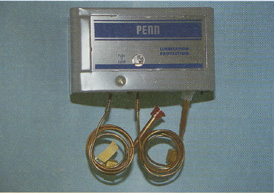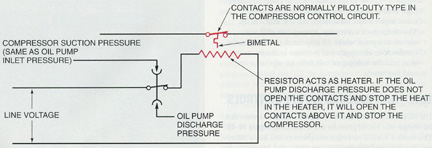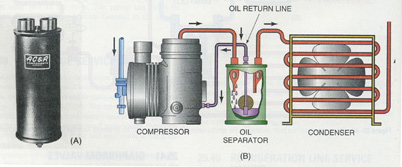Bob and Btu Buddy meet for a training lunch after the previous day's low oil in the sight glass service call.
Bob starts the conversation by saying, "The service call on that 100-ton compressor that didn't show any oil in the sight glass was really different yesterday. It seems like there is a lot to learn in this HVACR field."
Btu Buddy says, "Yes, there is a lot to learn and we are only working with the HVAC side, and no refrigeration. It is another subject altogether. There are a lot of similarities, but a lot of differences."
Bob says, "Let's learn the HVAC part before trying to explain the commercial refrigeration side of the business."
Btu Buddy says, "Good idea. Most technicians work on either one or the other. Heating and cooling technicians are rarely called on to work on refrigeration and refrigeration technicians rarely are called on to do heating or cooling. The common thread is the refrigeration cycle used for air conditioning and refrigeration. Actually, air conditioning uses high temperature refrigeration to cool air."
Btu Buddy then says, "Now let's get down to business. We were involved with oil and oil return with the service call yesterday. Let's start by saying that there are two fluids circulating in every refrigeration system, refrigerant and oil. They depend on each other for the proper circulation. Refrigerant oil is primarily used to lubricate the moving parts inside the compressor. There is actually supposed to be a thin film of the proper weight of oil between all moving parts. In a reciprocating compressor, there are a lot of moving parts. There are fewer moving parts in scroll compressors and rotary compressors. But the same oil theory is true for them. Without oil, they will not run for long. Notice that I said a thin film of the proper weight oil. Like a car, there are different weights of oil for different applications.
"Also, recall the service call that we had awhile back where liquid refrigerant was slowly moving into the compressor crankcase and causing the oil to be thin. Liquid refrigerant and oil make for poor lubrication. The compressor oil crankcase should always be warm; then you know there is no liquid refrigerant present."
Bob asks, "Why don't you change the oil in a compressor like you do a car?"
Btu Buddy explains, "A car has an internal combustion engine that gives off soot or carbon as a natural byproduct of the combustion. A compressor and refrigeration system are supposed to be assembled under very clean conditions and, for what little contamination may be left in the system, the filter drier is supposed to remove it. Clean field assembly procedures are essential. Air conditioning technicians have been known in the past for careless assembly. A little moisture will normally never be noticed. This is not true for refrigeration technicians. A circulating drop of water will stop a system by freezing at the expansion device, because most of them operate below freezing. The compressor, evaporator, condenser, and all other components are shipped to the job clean. When assembled correctly in the field, it is a clean system. The lubricating oil is in the system for life unless the compressor is changed."
Oil Circulation
Btu Buddy says, "Let's look at how the oil circulates in the system. As we talked about yesterday, the velocity of the refrigerant moves the oil along, in the bottom of the piping, through the coils and interconnecting piping. The coils are normally not a problem as they are designed at the factory for refrigerant and oil. The problem can be the field piping. This piping must be sized correctly or the oil will leave the compressor and not return. The compressor will run for short periods of time with low or no oil pressure, but not for long. Interconnecting pipe sizing is a long lesson of its own and we do not have time for the complete lesson. There is a delicate balance between piping that is oversized and undersized. Oversized piping will not have enough velocity to return oil and undersized piping will cause too much pressure drop and cause the system to be inefficient. It is fairly easy to move oil downhill. It becomes harder to move it uphill, as when the compressor is above the evaporator. The warmer the refrigerant, the easier it is to move oil. This is a difference in a refrigeration system with suction lines that may operate below 0 degrees F and air conditioning systems that operate at around 50 degrees F.
"Now suppose that the oil had dropped to a point that no oil pressure was available. I told you yesterday that the system had a very reliable oil pressure control. Do you know how they work?"
Bob says, "I would assume that it is a typical pressure control. When it senses pressure, it would have closed contacts and, when there was no pressure, the contacts would open."
Btu Buddy responds, "That is true up to a point. It has an internal pressure control that operates much like you said. Now the question is at what pressure would you set the control? Most compressors must have a minimum of 10 psig of net oil pressure for lubrication. Remember, the oil pump inlet pressure is the same as the suction pressure and it is a variable. We can't just set the control to shut off at 10 psig. We must use the control to measure the pressure difference across the oil pump. This brings up another problem. How do you measure pressure difference?
"I like to explain that pressure difference is like a seesaw. What happens if a 50-pound kid gets on one end of the seesaw and a 75-pound kid on the other? Of course the seesaw lowers on the heavy end because there is a difference in pressure. An oil safety control operates the same way. You can look at one of the older style controls and it has a diaphragm on the top of the control and a diaphragm on the bottom of the control; they are linked inside to counterbalance each other. The suction pressure is on one side and the oil pump discharge pressure is on the other (Figure 1). A simplified drawing of how these controls work, whether they are the new electronic versions or the older electromechanical types, can be seen in Figure 2.

Bob asks, "What would happen if the compressor were to be running and lose oil pressure? Would the heater circuit be energized and stop the compressor?"
Btu Buddy answers, "Yes, after 90 seconds or whatever time delay the manufacturer uses. The 90-second delay prevents nuisance shutdowns. Notice the control is manual reset. Someone must come and push the button to get the compressor to restart. It should be noted here that should a compressor shut down because of an automatic reset internal overload, it would also fail on oil pressure because the oil pump stops pumping oil. Manufacturers have put other controls in place to prevent this from happening. Some systems use a current transformer that will only energize the oil safety control when there is current flow to the compressor, ensuring that it will not trip on oil safety control because the compressor stopped due to the internal overload. The technician would mistakenly think there was an oil pressure problem when it was actually an overload problem.
"I also mentioned to you yesterday that some systems have an oil separator in the discharge line that will return oil to the compressor crankcase (Figure 3). This is not actually a cure-all because the oil separator will not take out all of the oil, as some of it will be in the vapor state and will move with the discharge gas on to the condenser. Several companies have different technologies and have different efficiencies for oil separators. For the system we worked on yesterday, the oil would probably never leave the compressor with an oil separator as it would have sometimes at near full load to return oil that went through the oil separator. An oil separator is not a cure for poor piping practices."

Good Piping Practices
Bob says, "Explain some tips for good piping practices."Btu Buddy notes, "We explained that velocity of the refrigerant is the key to moving the oil. We will first talk about refrigerant gas lines. The velocity in the lines should have a minimum velocity of about 500 fpm (feet per minute) and a maximum of 4,000 fpm. With a velocity less than 500 fpm, oil will not return. A velocity of over 4,000 fpm will cause inefficiencies and cause the piping to make excessive noise.
"Horizontal lines can be sized larger because the oil will be easier to move. All horizontal lines must be pitched downhill 1/2 inch per 10 feet toward the compressor to encourage the oil to move.
"Vertical lines are a different story. For a compressor that doesn't have the capability to unload, a single pipe may be used for vertical lift. It must have a trap about every 10 feet where oil will gather and cause an oil plug in the pipe. When this plug restricts the flow enough, the pressure drop across the trap will pull the oil puddle up the riser.
"Systems with variable capacity may have to have two suction lines to carry the refrigerant and oil up the rise. For example, the 100-ton compressor that would run at 100 tons down to 25 tons may have a 75-ton line and a 25-ton line that are piped in such a way that, at low load, the trap will gather oil and force the oil up the small 25-ton line or riser. This piping system is sized normally by the design engineer for the system. There are texts that explain how to size these lines. Copeland, Carrier, and Trane are manufacturers that furnish these texts. Normally the service technician would use their tables to check a system where trouble is suspected."
"Wow," says Bob, "this gets deeper by the day."
"Yes it does," says Btu Buddy. "Aren't we glad that we can learn it a little at a time as we come to it. It would be very difficult for a technician to learn it all and then go into the field. It is always best to travel in a truck with an experienced technician for some time before going out on your own, like you did. Then you start out on jobs that are within your capacity. Every technician has a Btu Buddy if they will just look around. It may be a textbook that is carried, a friend at a supply house, or another service technician, not to mention night classes and factory schools."
Bob says, "Thanks for the luncheon lesson. I am glad I have you to consult with."
Bill Johnson has been active in the HVACR industry since the 1950s. He graduated in gas fuel technology and refrigeration from the Southern Technical Institute, a branch of Georgia Tech (now known as Southern Polytechnic Institute). He taught HVAC classes at Coosa Valley Vocational & Technical Institute for four years. He moved on to become service manager for Layne Trane, Charlotte, N.C. He taught for 15 years at Central Piedmont Community College, part of this time as program director. He had his own business for five years doing installation and service work. Now retired, he is the author of Practical Heating Technology and Practical Cooling Technology, and continues as a co-author of Refrigeration & Air Conditioning Technology, 5th Edition, all published by Delmar Publishers. For more information, he can be reached at 704-553-0087, 704-643-3928 (fax), or bmj@myexcel.com.
Publication date: 11/15/2004

Report Abusive Comment